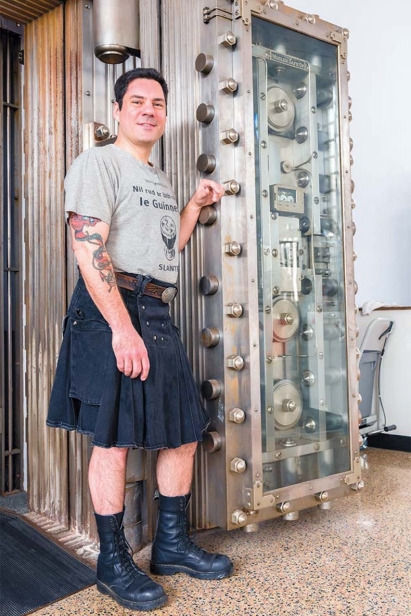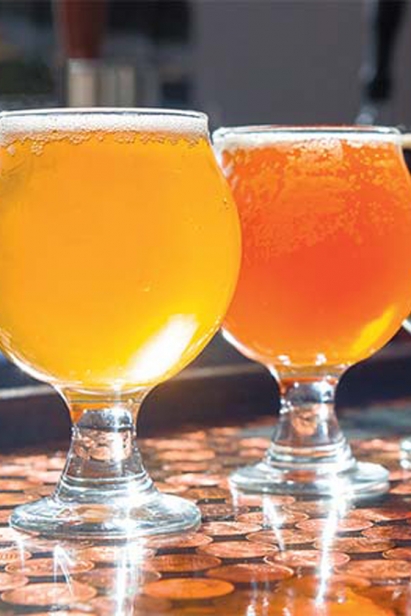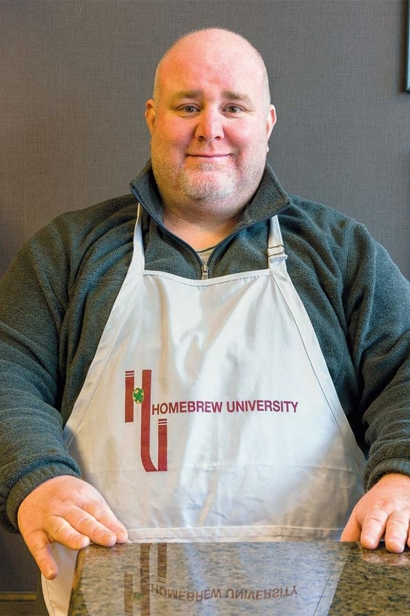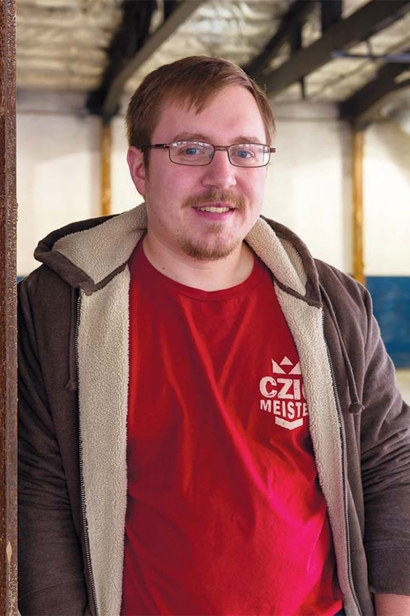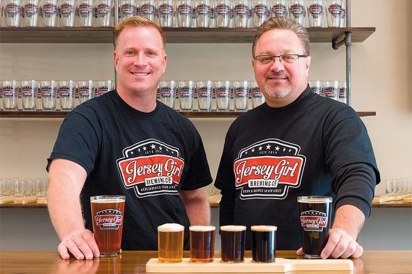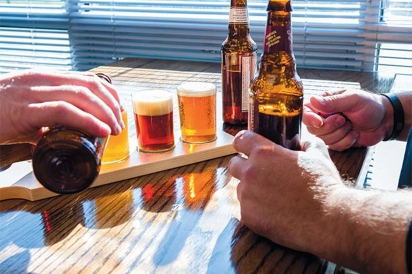Hackettstown: Jersey's Brew Town
With three new breweries and a school for homebrewers, Hackettstown sees the rise of an industry
Downtown Hackettstown has the same vintage feel as the vinyl section of a record store. Shop windows display antiques, used books, bicycles and period furnitute. And yet, there is a prevailing sense that a new trend is on the rise. Within a span of five months, three breweries will have opened in Hackettstown, two of them within a few blocks of an also-new homebrew store. Hackettstown, quite suddenly, has become a New Jersey craft beer destination.
MAN SKIRT
Inlaid in the wall of a brick building is a night depository, left over from a former bank, serving as camouflage to any passerby who doesn’t think to look up. A modest sign hangs overhead: No pants, just great beer.
Inside, on the raised floor where bank tellers once stood, a man in a brown canvas kilt pours off partially fermented pale ale from a 228-gallon cylindrical-conical tank. He tastes it first, before a quick dip of the hydrometer in the pail reveals how much alcohol the yeast has produced, which is not as much as he’d hoped.
“I started like everyone starts, with a pot on a stove and a plastic bucket. Most of what I know is from practice,” says Joe Fisher, the homebrewer turned founder of Man Skirt Brewing. When I visit, he’s just finished leading a class of curious Centenary College biology students around the brewery. The water profile, he explains to them and me, is more basic in Hackettstown than in his hometown of Lebanon, and as a result the pH of his usual mash is too high for the enzymes in the grain to convert starches into sugars for the yeast to eat. To compensate, he’ll add acidulated malt, a type of malted barley to which lactobacillic acid has been added—a common brewing technique in locales with alkaline water.
One of Man Skirt’s current brews is an English-style best-bitter ale that comes in at a sessionable 4.2% ABV and is decidedly not bitter, but rather falls on the malty-sweet side of the spectrum. Also on tap in his Kickstarter-funded tasting room is an American robust porter— not as heavy as a typical porter, it brings in rich dark chocolate and coffee notes with a surprisingly light mouth-feel.
Next in the brew kettle is a German bock brewed with rye flakes and peppercorns. Fisher plans to focus mainly on his favorites going forward— classic British styles, as well as American and German. “I need to make beer that I’m passionate about in order for people to like my beer,” he says. “If I’m forced to make styles I don’t like, it’ll show in the final product.”
Along with sourcing local hops, from farms like Bentley B. Hops in Newton and Rope Swing Hops in Green Township, Fisher’s ambitions include making use of a room in the brewery that’s still full of safe deposit boxes. The future Man Skirt cask room will feature barrel-aged brews “straight from the vault.”
Fisher stills works as a computer programmer when he’s not cleaning kegs and hauling bags of grain. In fact, it was his experience in electronics that compelled him to replace his original plastic bucket with a fully automated homebrew system he built from scratch in his basement.
HOMEBREW UNIVERSITY
One block east of Man Skirt is the brewers’ paradise known as Homebrew University. From the outside it looks like a general store, with vintage beer barrels and a cider press in the window, but inside it’s half chemistry lab and half intellectual café. Lining the walls are boil kettles, bottling stations and a shelf of custom-labeled beer bottles from a few of the 200 batches brewed here in the past year. In the center of the room are sealed barrels of malt and samples of pelletized hops. Customers wander among the starter kits or stop to talk with the owner, Warren Wilson.
Homebrew University serves as a one-stop shop for brewers from across the tri-state area—but it really is a school as well.
In 2009, when Wilson, Fisher, and a few others began a craft beer club called NJHOPZ, it was mainly to perfect recipes, tour breweries, learn as much as they could from one another and promote what Wilson calls “beer philanthropy.” By 2012, he had decided that as much as he loved to brew, teaching was the center of his business.
The next year, Homebrew University opened; it operated purely as a supply store until Wilson received his license to brew on-site in August 2014. Today, homebrewers enroll in classes to learn the history of different styles and how to formulate recipes, taste grain, smell hops and predict how beers will taste.
“With a homebrew store there’s already a following,” explains Wilson. “Knowing that two other folks were interested in opening breweries in town when I opened, I knew this place would become a destination, which I think Hackettstown needs.”
Yet even as the craft brewing industry swells around him, Wilson is never one to judge the drinkers of “the BMC”—Bud Miller Coors—recalling a time when he himself knew very little about beer. Though he consistently refers to those beers themselves as “yellow swill.”
CZIG MEISTER BREWING
Two blocks away from the store is the second of three breweries opening in Hackettstown within a year, this one owned by another founding member of NJHOPZ and frequent visitor to Homebrew University.
Czig Meister Brewing, the brainchild of Matt Czigler, former head brewer at Kane Brewing Company, is slated to open in the spring of 2016. Czigler plans to start with four year-round beers, which run the gamut of base flavors. A hoppy pale ale, a “malty-caramel” amber ale, a “malty-roasty” stout, and a “clean malty” Kölsch.
Kölsch is a traditional Old World German-style beer; it’s a hybrid ale and lager, as it uses an ale yeast that works better at lower temperatures. Because lagers are more time-consuming to produce than ales—the former need two or three weeks of fermenting plus a few months of conditioning, while the latter need only a week of fermenting—they are unpopular among craft brewers wary of investing extra space and time in a product that doesn’t bring extra profit. Czigler’s Kölsch will be the best of both worlds: a lager-type flavor with a touch of background fruitiness, after only one extra week in the tank.
All four Czig Meister originals will also undergo a unique “cold crash” method, which involves quickly dropping the temperature of the beer from 68˚ to 32˚ within 12 hours, in order to send the yeast to the bottom of the tank, improving clarity while avoiding filtering, which robs the beer of flavor. “I’ve filtered beers before at other places I’ve worked, and I just feel that the beer loses something,” Czigler says. With his method: “You’ll be able to see your hand through it, just maybe not read a book through it.”
Czigler has a strong science background in microbiology and biochemistry, which earned him a spot in the 2011 class of the prestigious Siebel Institute, a brewing school with campuses in Chicago and Germany.
A year later, Czigler was working at the Adirondack Brewery in Lake George, New York, when Governor Christie signed into law a bill that allowed New Jersey breweries to have tasting rooms. Before this, they could only sell one growler after a brewery tour; now visitors could buy pints, flights, growlers, bottles and cans totaling up to a keg’s worth, 15½ gallons.
In 2014, after two years at Kane Brewing, Czigler set out to take advantage of the new law and bring Hackettstown further into the realm of beer tourism. “The way I look at it, one brewery is great,” he says, “but if people outside the area hear there are two, it makes it more of a destination, especially with all the restaurants in the area.” The new law does prohibit selling food on the property, but it doesn’t prohibit “BYOF”—which is to say, customers bringing their own food or ordering takeout.
JERSEY GIRL
Actually on the edge of Mount Olive—but close enough to have a Hackettstown address—is Jersey Girl Brewing Company, which just opened in December 2015. Jersey Girl was founded by friends Chuck Aaron and Mike Bigger, two craft beer lovers and avid homebrewers who plan on employing a limited-edition brew process similar to Czigler’s, on a 20-gallon “tippy” system, in addition to year-round and seasonal offerings brewed on a larger scale.
“We’d like to get members of the community to come out and help us brew on the tippy,” Bigger says. Aaron adds, “It’d even be fun to have people bring their own recipe in, brew it in the 20-gallon system, try it here, and see how it goes.”
Aaron and Bigger built their tasting room before the equipment even arrived at the former warehouse on Sand Shore Road, because it’s a vital piece of their strategy: It’s not just a tasting room but a testing room, where they can gauge the reactions to their tippy and seasonal varieties. Their plan, like Czigler’s, is to develop four flagship beers—a Belgian-style, a vanilla porter, an American pale ale and an IPA—but their seasonal selection will likely evolve based on visitors’ reactions in the tasting room.
“You can do a lot in sample rooms,” says Aaron. “We’re not a bar, so we don’t want to act like one. We might look like one, but for us this is more of a classroom than anything else. I’m not sure if everybody in the US approaches it that way, but in New Jersey, that’s what we need to do.”
In keeping with the local name, Bigger hopes to use cranberries, blueberries and peaches to put a New Jersey spin on a craft beer market dominated by pumpkin in the fruit sector. But the real Jersey Girl claim to fame will be in the water. Via reverse osmosis, the well water that supplies the brewery will be neutralized, then rebuilt to include the minerals and salts from the region of the beer the brewmaster wants to imitate. For a Scottish ale, Aaron explains, you’d research the Edinburgh water table to find out what kind of mineral content that area has and build off of that. “If you’re going to make great beer,” he says, “it comes down to choosing the best ingredients you can get your hands on, starting with a great water.”
There is a camaraderie among the brewers of Hackettstown. Each has at some point asked another for advice: on a recipe, on new laws, on ingredients, on equipment, on teaming up with local restaurants. It’s not unusual to find Joe, Warren, Matt, Chuck and Mike having a pint at the Taphouse Grille in Hackettstown on five adjacent stools. To them the bar is a roundtable, and a night out means talking shop.
“In my experience, you and your competitors never talk,” Chuck Aaron says. “But we’re different enough, and the market is big enough, that it’s more about getting together with the guys that are going through what you’re going through. Talking about how to make a better product or overcome a challenge—it’s just really refreshing.”
CZIG MEISTER BREWING COMPANY
106 Valentine St., Hackettstown
Opening April 2016
HOMEBREW UNIVERSITY
160 Main St., Hackettstown
908.452.5352
Hours: Tues-Fri 11am-7pm; Sat 10am-6pm
JERSEY GIRL BREWING COMPANY
426 Sand Shore Rd., Hackettstown
908.591.4186
Opening March 1, 2016
MAN SKIRT BREWING
144 Main St., Hackettstown
908.989.0286
Hours: Thurs & Fri 6pm-9pm; Sat 4pm-9pm



